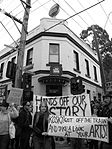Victoria Park railway station, Melbourne

Victoria Park railway station is located on the Mernda and Hurstbridge lines in Victoria, Australia. It serves the north-eastern Melbourne suburb of Abbotsford, and it opened on 8 May 1888 as Collingwood. It was renamed Victoria Park on 1 May 1909.Between 1888 and 1901, the station was the terminus of the Collingwood to Heidelberg railway line. Until a direct connection with the Melbourne CBD was opened in 1901, between Princes Bridge and Collingwood, the only connection to the city centre was via the indirect Inner Circle line. On 21 March 1959, the station platforms were damaged by a fire that occurred at a nearby timber yard.A former goods yard is located next to Platform 1, whilst a stabling siding, capable of holding two stabled trains, is located at the Down (northern) end of the station. The present station buildings were constructed in 1981, with the original wooden pylons that supported the former buildings removed soon after.The station is adjacent to Victoria Park, the former home of the Collingwood Football Club between 1892 and 1999. Large numbers of people used Victoria Park station to travel to and from AFL matches played at the stadium.
Excerpt from the Wikipedia article Victoria Park railway station, Melbourne (License: CC BY-SA 3.0, Authors, Images).Victoria Park railway station, Melbourne
Little Turner Street, Melbourne Abbotsford
Geographical coordinates (GPS) Address Nearby Places Show on map
Geographical coordinates (GPS)
| Latitude | Longitude |
|---|---|
| N -37.7991 ° | E 144.9945 ° |
Address
Platform 1
Little Turner Street
3067 Melbourne, Abbotsford
Victoria, Australia
Open on Google Maps










